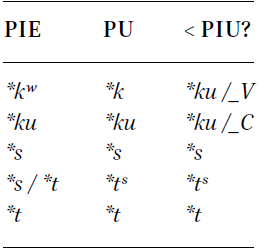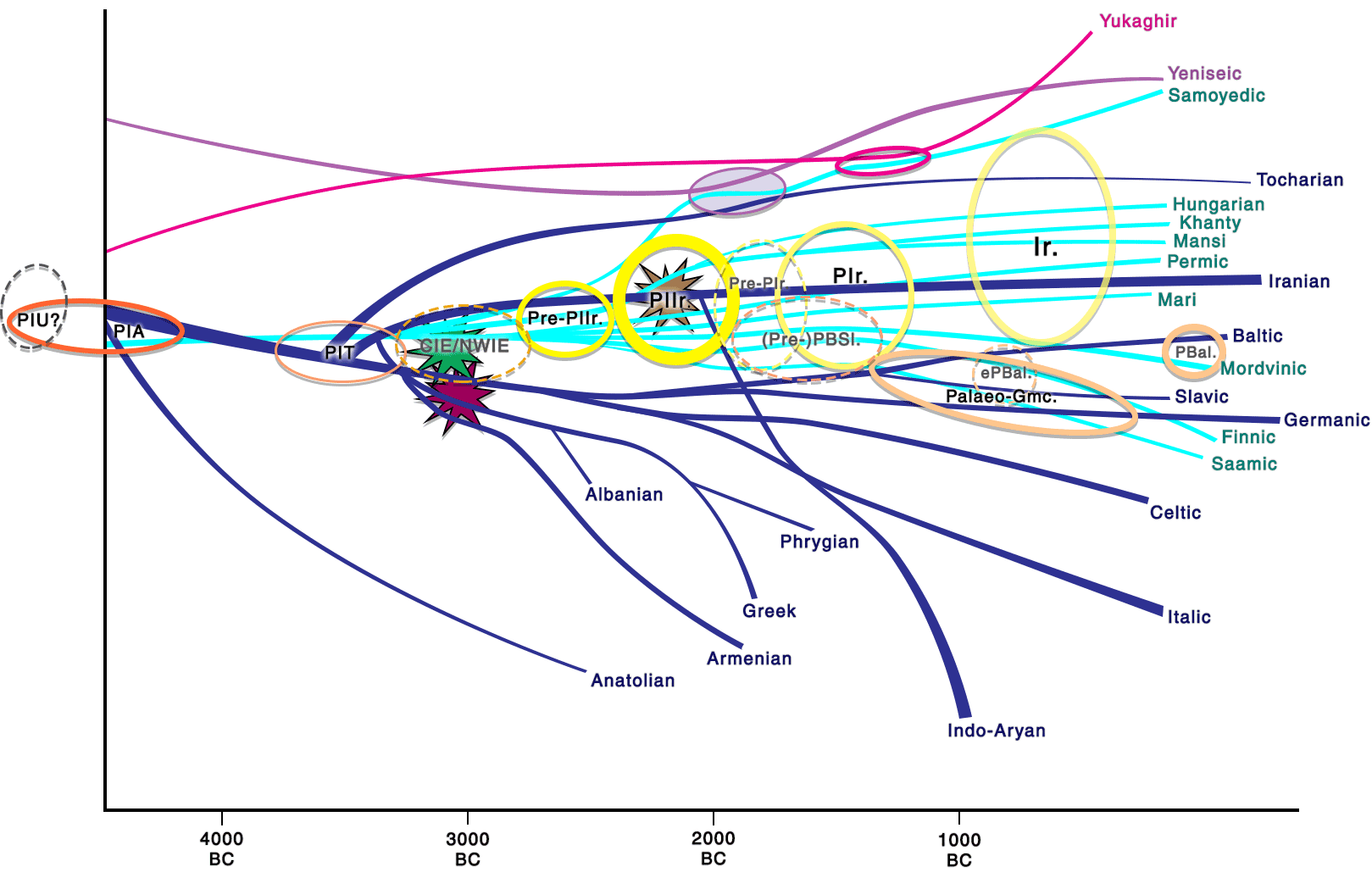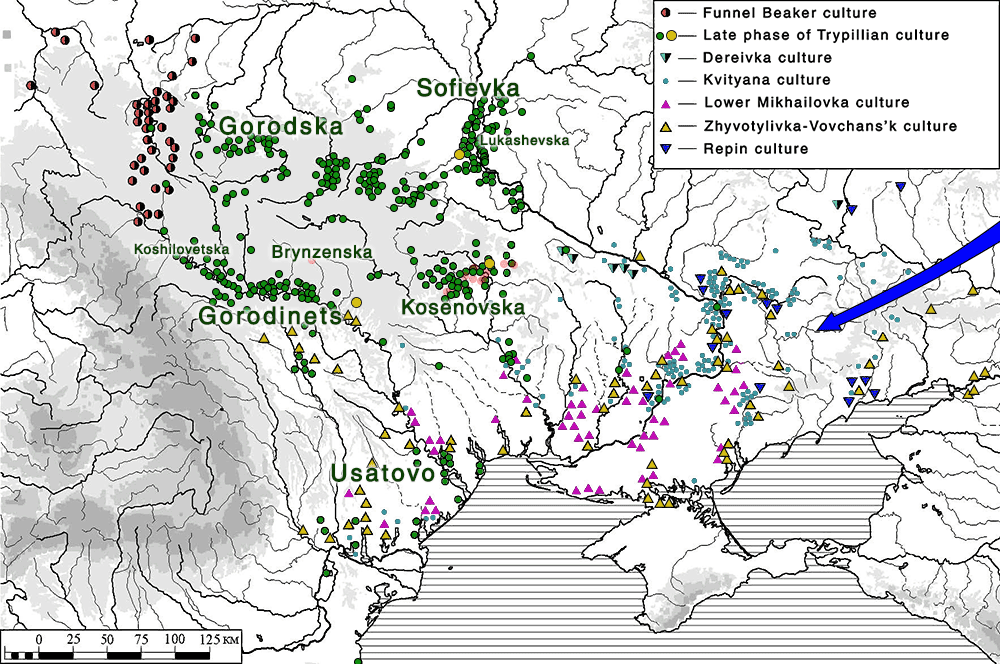This post is part of a draft on palaeolinguistics and the Proto-Uralic homeland. See below for the color code of protoforms.
14. Earliest PU ~ PIE contacts
14.1. Indo-Uralic?
The most reliable correspondences to propose an Indo-Uralic phylum come from basic morphological comparisons. Some of the most frequently mentioned ones include (e.g. Čop 1975, Kortlandt 2002, Bjørn 2019, or Lubotsky 2019):
- Nominal endings:
- PU nom.sg. *-Ø ~ PIA nom.-acc.sg. *-Ø (in neuter athematic nouns).
- PU acc.sg. *-m ~ PIA acc.sg. *-m.
- PU dual *-ki(-) ~ PIA nom.-acc.du. *-h₁.
- PU abl. *-tA ~ PIA gen.-abl.sg. *-es/*-os/*-s.
- PU nom.pl. *-t ~ PIA nom.pl. *-es.
- Personal pronouns: 1.sg. *mi, 2.sg. *ti.
- Verbal endings:
- 1.sg. *-mi, 2.sg. *-ti/-si.
- 1.pl. *-me, 2.pl. **-te.
- Interrogative pronouns:
- PU *ki ~ PIA *kʷi-.
- PU *ku-(*ko-) ~ PIA *kʷo-.
- Anaphoric and relative pronouns PU *i-? ~ PIA *i-.
- Deictic:
- Animate PU *so(n) ~ PIA *so.
- Inanimate PU *to/tu ~ PIA *to.

Interesting is the proposal of PU nasals (and laterals) ~ PIA implosives, especially because it would support the internal evolution of velars in PIE (Kümmel 2019; Kroonen 2019), but many cases proposed remain questionable. What is more, it is impossible to distinguish which was the archaic PIU situation (or donor language), i.e. whether PU *p~m, *t~n, *k~ŋ? ← PIA *ɓ, *ɗ, *ɠ or PU *m, *n, *ŋ → PIA *m~ɓ, *n~ɗ, *ɠ?, or even a combination of them.
Also promising seems the reappraisal of Čop’s Indouralica series in Klemenčič (2019) and especially in Zhivlov (2019), where PIU (≈ PU) stem types and Indo-European ablaut paradigms are compared to obtain regular stem nouns with regular suffixes.
14.2. Indo-Anatolian/Indo-Tocharian/Core Indo-European
A few lexical parallels between early Proto-Uralic and Proto-Indo-European are today firmly established. Most examples belong to elementary and universally known actions, which – even though not very useful for palaeolinguistic purposes – marks a very early, long-lasting and close contact with PIE.
Surprisingly, two of these considered undisputed examples – ‘name’ and ‘water’ (Koivulehto 1991, 2001; Kortlandt 2002, Häkkinen 2009, Bjørn 2019, Aikio 2019) – belong to a layer that cannot be simply attributed to Indo-Tocharian, due to changes in adopted vocalism potentially signaling the oldest contacts on the part of Proto-Uralic (*i ← PIE *e) or Proto-Indo-European (without Late PIE vocalism), which makes a distinction between shared heritage or contact phenomena impossible:
- PU (Saa., Fi., Md., Ma., P, Kh., Ms., Hu., Smy.) *nimi ‘name’ (UEW Nº 597) ~ PIE **h₃néh₃mn̥? cf. LPIE *(h₃)nomn̥- ‘name’.
- PFU (Saa., Fi., Md., Ma., P, Kh., Ms., Hu.) *wixi- ‘take, transport’ (UEW Nº 1148) ~? PIE *u̯egʰ- ‘travel; move, bring, transport’ → LPIE pres. *u̯égʰ-e- (but cf. *u̯i-u̯gʰ-é- in O.Ind. ū́hati), aor. *u̯égʰ-(s-) (LIV²: 661-662).
- PU (Saa., Fi., Md., Ma., P, Ms., Hu., Smy.) *weti ‘water’ (UEW Nº 1142) ~ PIE *wed-(e)n̥/r̥- (PIA Nom. wódr̥, Gen. *wédn̥s/*udéns, etc.) ‘water’.
- PFU (Saa., Fi., Ma., P, Kh., Ms.) *wosa ‘product, trade’ (UEW Nº 1170) ←? PIA *wos-n̥ ‘sale’ or PIA/PIE? *wos-e-i- (see above Trade).
- PU (Saa., Fi., Md., P? Kh., Ms., Smy.) *mexi-/*me̮xi- ‘give/sell’ (UEW Nº 542) ~? PIE *h₂meigʷ- (LIV²: 279).
NOTE. The i-stem and the isolated case of change PIE *-gʰ- (**-gʲʰ-?) → PU *-x- suggest that it belongs here, but v.i. for a discussion on this dubious PU phoneme.
NOTE. The e-stem would put the borrowing in the later, fully regular layer, but it must have been a quite early loan due to the widespread PIA/PIE o-stem. After all, it is unlikely that a language would borrow from the oblique case. No reason to support a borrowing from PIIr. *udá(n) (Holopainen 2019), although it is unclear what the oblique form might have been like in Pre-PIIr. Absent in Saami and Khanty, where PFU? *ćäčä ‘water / flood’ is used instead, so it has been suggested as the original Uralic word for ‘water’. Nevertheless, as Aikio (2020:109) notes, this would imply an unusual semantic development from ‘water’ to ‘flood’ (and further a specific kind of flood) in Khanty.
NOTE. This example would reinforce the substitution of PIA velars by (Pre-)PU *x, and it is indirectly supported by the adoption of *wosa in the same semantic field. However, without further similar examples, the assumed substitutions remain rightfully disputed.
PU ~ PIE correspondences which follow the same phonological regularity as later borrowings but which feature laryngeals (or a general PIE reconstruction) can be assumed to belong to their early contacts. Lacking an uncontroversial consonantal evolution of Proto-Indo-European and a proper evaluation of (Pre-)Proto-Uralic correspondences, PIE vocalism (i.e. laryngeal loss and vowel colouring) remains thus the main feature to recognize potential Indo-Tocharian or Core Indo-European loans:
- P(F)U (Fi., P, Kh., Ms., Smy.?) *kaja ‘dawn / sun’ (UEW Nº 330) ~ PIE *h₂ej-er/n- → LPIE *haj-er/n- ‘day, morning’.
- PU (Saa., Fi., Md., P, Kh., Hu., Smy.) *kulki- ‘move, run, flow’ (UEW Nº 387) ~ PIE *kʷ(e)lh₁-(e-), *kʷolh₁-éje- ‘turn, move around, revolve around’ (LIV²: 386-387).
- PU (Md., P, Ms., Hu. Smy.) *pexi ‘cook; boil’ (UEW Nº 735) ~? PIE? *bʰeh₁- ‘to warm’ a root only found in Germanic (LIV²: 67-68), with a dubious appurtenance of Arm. bov, which renders the reconstruction for LPIE uncertain.
- PFU (Saa., Fi., Md., Hu.) *teki- ‘do; put’ (UEW Nº 1044) ~ PIE *dʰeh₁- → LPIE *dʰeh-mi ‘do; put, place’ but cf. also dial. ie-present *dʰeh-je- in PBSl., PIta.? (LIV²: 136-138).
- PU (Saa.? Fi., Kh., Ms.? Hu.? Smy.) *toxi- ‘give’ (UEW Nº 1061) ~ PIE *deh₃- ‘give’ → LPIE pres. 1p. *dé-doh-mi aor. 1p. *doh-m (LIV²: 105-106).
- PU (Saa., Fi., Ma., Kh., Ms., Smy.) *suxi- ‘to row (a boat)’ (UEW Nº 911) ~ PIE *suH- ‘drive, keep moving’ (Sammallahti 1988: 540), cf. Hitt. suwezzi, suwanzi (← *suH-jé-), but LPIE *suHé-, cf. PCel. *sowe-, O.Ind. suváti (LIV²: 538-539).
NOTE. Particularly relevant as external constraints to still widespread Proto-Indo-European reconstructions are the lack of influence of palatovelars in loans that do not belong to Indo-Iranian or Balto-Slavic branches (cf. also Holopainen 2018), as well as the lack of laryngeal replacement in other Late PIE or Pre-PIIr. sources, where most reconstructed parent IE protoforms still ignore the obvious laryngeal loss common to all Core Indo-European dialects. Nevertheless, some of the stems classified as potentially PIE – also PIE/NWIE or PIE/Pre-PIIr., depending on their distribution – lack a laryngeal to help further clarify the most likely layer of borrowing.

Of course, the proposals above reflect the attribution of Indo-Tocharian vocalism by assuming a borrowing in the most likely direction. The assumption of a genetic relationship complicates things for that simplistic comparison, though. For example, Kortlandt’s (2002: 217-227) explanation that “The rounded laryngeal *q₃ of Indo-European *deq₃- ← *toqi- suggests that the non-initial vowel was rounded as a result of Indo-Uralic vowel harmony in this root.” is interpreted by Peyrot (2019: 191) as PIU (= PU) *toxi- → *toxu- → *texu- → *deqʷ- → PIE *deh₃-. Similarly, the proposals of PU *k/*x ~ PIE *K/*H correspondences by Hyllested (2009) depending on their specific environment assume a universal common origin in PIU stems.
On the other hand, while the assumption that PU ≈ PIU is still the main idea underlying a potential Indo-Uralic phylum, it is important to remember that the discussion of these protoforms cannot be based (solely) on the phoneme *x, since it represents an unknown (velar?) consonant, possibly – as traditionally represented – a voiced velar fricative or glide (≈ *ɣ). Given that its status, environment (essentially *CVxi-) and reconstruction in PU is unclear, it cannot be formally used to distinguish supposed layers either in PU or from PIE. Its marginal position in the PU phonological system and the fact that it almost always occurs as a substitute for PIE laryngeals (also of ambiguous nature) makes all these PU words – about ten sure stems (Aikio 2019: 10-11) – suspicious of being ultimately PIE loans (cf. Koivulehto 1991, passim).
NOTE. Aikio’s (2019: 50) suggestions to explain the – admittedly slippery – phonetic rules that must have governed these early PU ~ PIE contacts include (1) borrowings within an early Uralic dialect continuum that postdated the disintegration and spread of Proto-Uralic; (2) a mediation of borrowings by unknown intermediate languages; and (3) occasionally chance similarities. All seem alternative ad hoc nonexplanations intentionally proposed in generalizing terms, hence impossible to prove or disprove. His skepticism about the relevance of the multiple layers of contacts with Indo-European contrasts sharply with his hopes immediately after that (Aikio 2019: 53-54) about finding more “interesting lexical similarities with Eskimo-Aleut” and an “Eskimo-Uralic” genetic relationship, since “in an unbiased inspection the potential lexical correspondences between Proto-Uralic and Proto-Eskimo-Aleut do not seem to be any less promising than those between Proto-Uralic and Proto-Indo-European or Proto-Yukaghir.”
15. Agricultural Substratum
Koivulehto’s many proposals (see Bibliography below) of a change PIE *H → PU *š face an insurmountable obstacle: most etyma including *š are suspicious of belonging to an Agricultural Substrate that acted before and during the dissolution of the proto-language.
NOTE. The first part of this discussion, including formal aspects defining the Agricultural Substrate, was separated and added as an independent section at the end of Apiculture & Agriculture to help with the reading of the draft.
The most relevant aspect of the Neolithic package reflected in many Early Uralic cognates is not its irregularity in broad terms, as emphasized by Aikio (2014: 128) when describing the “recent nativization” of “non-Uralic” words. That irregularity and limited distribution is also clearly shared by many words usually considered native Proto-Uralic terms in most texts (including his), probably due to their anthropological context not deemed improper of isolated hunter-gatherers.
The apparent a priori assumption in Aikio (2015) that “Finno-Permic” dialects branched off from some isolated region around Siberia, where more native Uralic branches remained untouched by technology, is naïve and untenable in archaeology and population genomics. So is in linguistics the suggestion of Janhunen (1981) and Sammallahti (1988) that PU *š arose as a secondary innovation after the breaking up of Proto-Uralic, based solely on its low frequency in terms with wide distribution.
There is an equally justified reason to assume that more eastern branches lost some of these recently incorporated Neolithic-related words as they became unnecessary during their migrations to the East and North. In fact, the phoneme clearly existed in the parent language, and it is also present in words with a wide distribution and completely regular phonetic correspondence, which are coincidentally basic or general terms (viz. *jäkši- ‘cold’, *šiŋir(i) ‘mouse’, *kajši- ‘be sick’, or *pušV- ‘blow’).

The most pertinent aspects of the Agricultural Substrate (AS) are its relative and absolute chronology and likely geographical area, which can be delimited based on internal and external constraints:
- Vocabulary reconstructed from the different fields above support an influence of the main Neolithic AS ranging from Proto-Uralic to its Disintegrating stage, among split-up dialects still in close contact.
- Based on its distribution and regularity:
- AS influenced PU later than regular PIA loanwords (PIU?), which sets a terminus post quem ca. mid-5th millennium BC, after the demise of the Khvalynsk-Novodanilovka community.
- AS influenced PU between PIT ~ CIE/NWIE ~ Pre-PIIr. loanwords, which sets a terminus ante quem ca. mid-3rd millennium BC, before the emergence of Catacomb-Poltavka.
- Anthropological inferences based on archaeological findings of (1) Neolithic subsistence economy and (2) Metalworking, as well as (3) the correspondence of substratal words with NWIE, help further delimit AS in time and space, close to the West Yamnaya community.
- The more irregular nature (and thus later influence) of PIIr. borrowings helps guesstimate the already split-up and physically separated Uralic dialects well before the Sintashta-Potapovka community of the end-3rd millennium BC.
- The late influence of the “language of the geminates” in Northern Europe (underlying Pre-PFi., Pre-PGmc., and marginally Pre-PCel. developments) probably discards Funnel Beaker (and/or Globular Amphorae?) culture as the Eastern European community behind the AS.
- The lack of agriculture and animal husbandry among Comb Ware and other Para-Neolithic groups from Eastern Europe before the spread of the Corded Ware culture helps also discard all other cultures from North-Eastern Europe and Northern Asia.
Language contact is the most likely reason for language change (see above Trudgill 2020, Nevalainen et al. 2020) and there is no clearer catalyst for the split-up of Proto-Uralic than the strong influence of this (initially foreign) agriculturalist substratal population, as well as the adstratal influence of Late PIE/Pre-PIIr. neighbours that must have coexisted with Uralic speakers for centuries at roughly the same time. In this sense, the situation is similar to the development of vocabulary for cattle, horse, wheel, chariot, metal, and later agricultural terms in Indo-European.
The only known event in archaeology and population genomics that coincides with all the data above is the apparent genetic replacement of the Anatolia Neolithic-like Trypillia genetic stock in the Late Trypillia (CII) period, during the second half of the 4th millennium BC, by peoples of so-called “Steppe” ancestry (cf. Immel et al. 2020; Sirak et al. 2020) – likely foragers of the North Pontic area who knew rudimentary animal husbandry, as reflected in the reconstructed PU vocabulary .
This population was subsequently involved in the expansion of the Corded Ware culture and its offshoots, associated with ancient Uralic-speaking cultures (cf. Jeong et al. 2018, with results mapped; Saag et al. 2019). In fact, Corded Ware ancestry still predominates among modern Uralic peoples, as well as Eastern and Northern Europeans of Uralic descent (cf. Tambets et al. 2018; Jeong et al. 2018, with results mapped; Haak et al. 2015 in Iain Mathieson 2019 [min. 5:56]; Santos et al. 2020). Furthermore, it is the only ancestry component common to all Uralic-speaking groups, except for recently acculturated populations from Northern Asia.

and ANE-related populations. In light blue, Uralic-speaking peoples; In dark blue, recently acculturated Uralic peoples (Northern Russians); In purple, Kets. Sources of admixture for each cline are represented using proxy ancient populations, both sampled and hypothesised, based on Jeong et al. (2018) modelling results. The major eastern and western ancestries used to model each cline are shown in bold; the peripheral admixtures that gave rise to these are also shown. Additional contributions to subsections of each cline are marked with dashed lines. Image modified from Cassidy (2018) – read the PDF here.
Proto-Uralic peoples must have been immediate neighbours of Proto-Indo-Europeans for millennia to account for their (dis)continuous linguistic contacts, so they must have formed within the same Neolithic Mating Networks of the Pontic-Caspian region. By the Final Eneolithic period, Corded Ware-related “Steppe” ancestry was clearly different from the Yamnaya/Afanasievo-related one, proper of Indo-Tocharians (cf. Wang et al. 2019, with data mapped here; Ning et al. 2019; Wang et al. 2020), a now well-established fact that is also supported by the differing Y-DNA bottlenecks that accompanied the spread of each ancestry component. Nevertheless, it is still unknown how (Pre-)PU contacts with Indo-Tocharians and Indo-Anatolians unfolded in archaeology and population genomics, and whether or not it will be possible to pinpoint an ancestral Indo-Uralic community.
References
See full Bibliography.
Color code for protoforms
- certain | uncertain
- PU/PFU | PFP/PWU/PFS/PFV/PUg.| Dialects
- PIE (PIU?) | PIE? (PIU??)
- PIE/Pre-PIIr. (PIU??) | Pre-PIIr. | PIIr. | PIr.
- NWIE | Pre-PGmc./(Pre-)PBSl. | PGmc./PBal./(Pre-)PSlav.
- Substrate | Substrate?
- Agricultural: PU | PU? | PIE | PIIr.
- Geminates | Eurasian (Wanderwort?)
- Palaeo-European | Palaeo-Laplandic/Arctic
Return to the sections above: ↑ 14. Earliest PU ~ PIE contacts or ↑ 15. Agricultural Substrate.
Featured image: Erdal-Bilderreihe Nr. 117 Bild 1, Die Bandtöpfer 1 by Gerhard Beuthner (1937?).